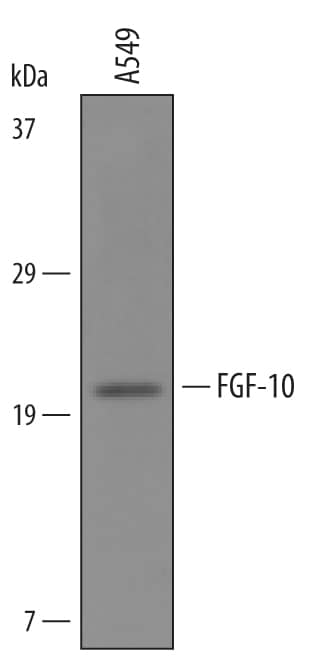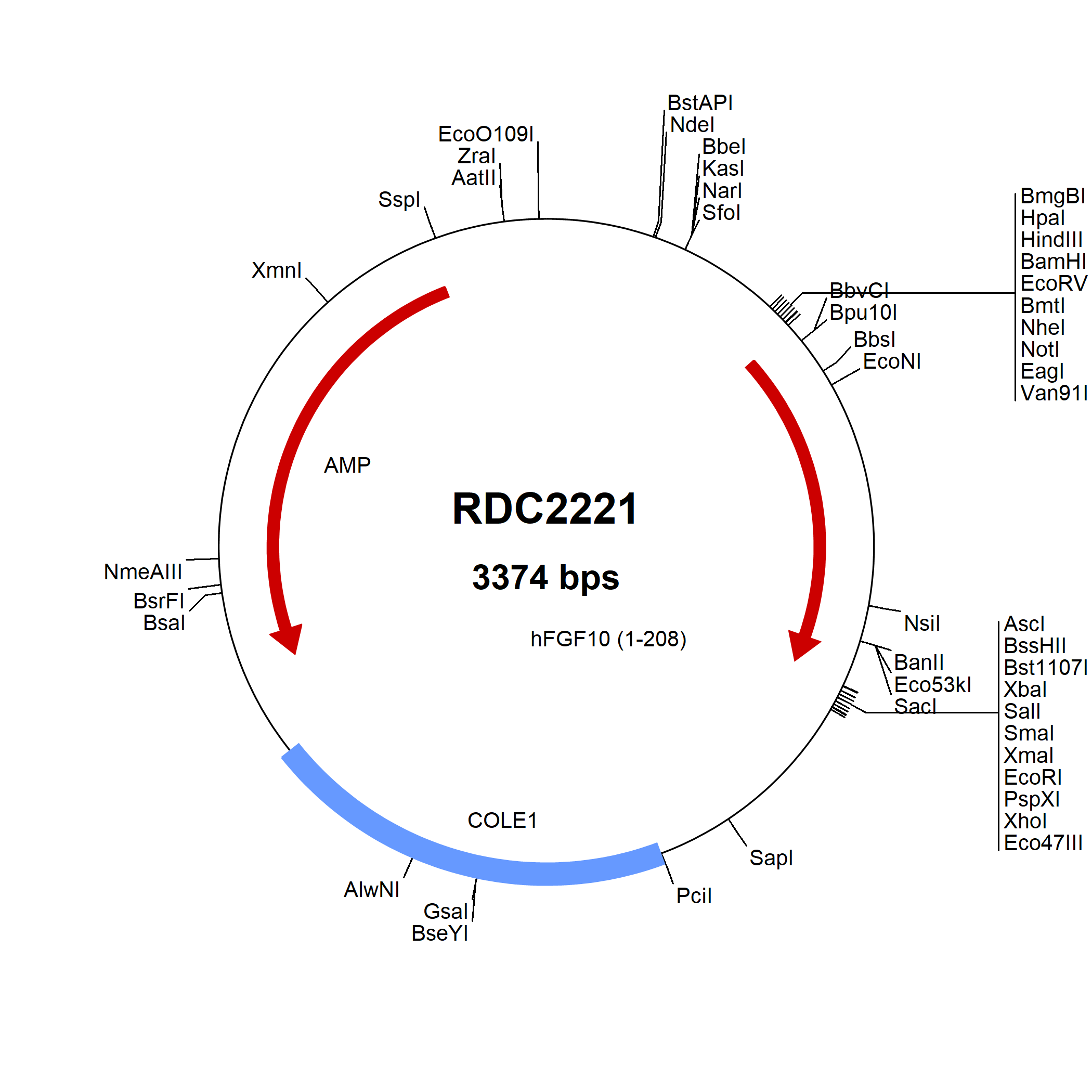FGF-10 Products
FGF-10 (Fibroblast Growth Factor 10) is a heparin binding glycoprotein in the subgroup of FGFs that also includes FGF-3, -7, and -22. FGF-10 is secreted by mesenchymal cells and associates with extracellular FGF-BP. It preferentially binds and activates epithelial cell FGF R2 (IIIb) and interacts more weakly with FGF R1 (IIIb). The mitogenic and chemotactic properties of FGF-10 are critical in limb bud initiation, palate development, branching morphogenesis and directional outgrowth of lung buds, formation of the otic vesicle and chochlea, adipogenesis, and the development of prostate, mammary, lacrimal, and submandibular salivary glands. The expression and function of FGF-10 are negatively regulated by Shh and BMP-4 in the developing lung. Overlapping expression patterns and activities with FGF-3, -7, and -8 suggest at least a partial redundancy in FGF-10 biology. FGF-10 induced signaling through FGF R2 (IIIb) also contributes to the progression of pancreatic cancer.
94 results for "FGF-10" in Products
94 results for "FGF-10" in Products
FGF-10 Products
FGF-10 (Fibroblast Growth Factor 10) is a heparin binding glycoprotein in the subgroup of FGFs that also includes FGF-3, -7, and -22. FGF-10 is secreted by mesenchymal cells and associates with extracellular FGF-BP. It preferentially binds and activates epithelial cell FGF R2 (IIIb) and interacts more weakly with FGF R1 (IIIb). The mitogenic and chemotactic properties of FGF-10 are critical in limb bud initiation, palate development, branching morphogenesis and directional outgrowth of lung buds, formation of the otic vesicle and chochlea, adipogenesis, and the development of prostate, mammary, lacrimal, and submandibular salivary glands. The expression and function of FGF-10 are negatively regulated by Shh and BMP-4 in the developing lung. Overlapping expression patterns and activities with FGF-3, -7, and -8 suggest at least a partial redundancy in FGF-10 biology. FGF-10 induced signaling through FGF R2 (IIIb) also contributes to the progression of pancreatic cancer.
| Source: | E. coli |
| Accession #: | O15520 |
| Applications: | BA |
| Source: | E. coli |
| Accession #: | NP_032028.1 |
| Applications: | BA |
| Reactivity: | Mouse |
| Details: | Sheep IgG Polyclonal |
| Applications: | WB, IHC |
Human/Rat/Bovine/Porcine
| Source: | E. coli |
| Accession #: | O15520.1 |
| Applications: | BA |
| Reactivity: | Human |
| Details: | Mouse IgG2b Monoclonal Clone #186803 |
| Applications: | WB |
| Applications: | ELISA |
| Reactivity: | Human |
| Details: | Goat IgG Polyclonal |
| Applications: | WB, ELISA, IHC |
| Reactivity: | Human |
| Details: | Mouse IgG3 Monoclonal Clone #963521 |
| Applications: | ELISA |
| Reactivity: | Human |
| Details: | Goat IgG Polyclonal |
| Applications: | WB |
| Source: | E. coli |
| Accession #: | P70492 |
| Applications: | BA |
| Applications: | ELISA |
| Reactivity: | Human |
| Details: | Mouse IgG2a Kappa Monoclonal Clone #3C7 |
| Applications: | WB, ELISA, Func |
| Reactivity: | Human |
| Details: | Rabbit IgG Polyclonal |
| Applications: | WB |
| Reactivity: | Human |
| Details: | Mouse IgG2b Kappa Monoclonal Clone #C2 |
| Applications: | ICC/IF |
Recombinant Monoclonal Antibody
| Reactivity: | Human |
| Details: | Rabbit IgG Monoclonal Clone #014 |
| Applications: | ELISA |
| Reactivity: | Rat |
| Details: | Mouse IgG1 kappa Monoclonal Clone #C1 |
| Applications: | ELISA |
| Reactivity: | Human |
| Details: | Rabbit IgG Polyclonal |
| Applications: | ELISA |
| Reactivity: | Human |
| Details: | Rabbit IgG Polyclonal |
| Applications: | IHC, WB, IP |
| Reactivity: | Human |
| Details: | Rabbit IgG Polyclonal |
| Applications: | WB |
| Reactivity: | Human |
| Details: | Rabbit IgG Polyclonal |
| Applications: | IHC, WB, IP |
| Reactivity: | Human |
| Details: | Rabbit IgG Polyclonal |
| Applications: | ELISA |
| Reactivity: | Human |
| Details: | Rabbit IgG Polyclonal |
| Applications: | WB |
| Reactivity: | Human |
| Details: | Rabbit IgG Polyclonal |
| Applications: | WB |
Recombinant Monoclonal Antibody
| Reactivity: | Human |
| Details: | Rabbit IgG Monoclonal Clone #014 |
| Applications: | ELISA |






![ELISA: Human FGF-10 - Ready-To-Use ELISA Kit (Colorimetric) [NBP3-31612] - Human FGF-10 - Ready-To-Use ELISA Kit (Colorimetric)](https://resources.bio-techne.com/images/products/nbp3-31612_human-fgf-10-ready-to-use-elisa-kit-colorimetric-206202415301578.png)

![ELISA: Human FGF-10 ELISA Kit (Colorimetric) [NBP3-31611] - Human FGF-10 ELISA Kit (Colorimetric)](https://resources.bio-techne.com/images/products/nbp3-31611_human-fgf-10-elisa-kit-colorimetric-20620241533981.png)
![Proximity Ligation Assay: FGF-10 Antibody (3C7) [H00002255-M05] Proximity Ligation Assay: FGF-10 Antibody (3C7) [H00002255-M05]](https://resources.bio-techne.com/images/products/FGF-10-Antibody-3C7-Proximity-Ligation-Assay-H00002255-M05-img0001.jpg)
![Western Blot: FGF-10 Antibody [NBP2-99399] Western Blot: FGF-10 Antibody [NBP2-99399]](https://resources.bio-techne.com/images/products/FGF-10-Antibody-Western-Blot-NBP2-99399-img0002.jpg)
